Nestled among the limestone mountains of Ha Giang province, Lung Tam weaving village stands as a vibrant testament to the preservation of Hmong cultural heritage. This remote community has transformed ancient linen-making traditions into a sustainable livelihood that empowers local women while safeguarding indigenous craftsmanship. Visitors to Lung Tam witness the complete journey of flax transformation from plant to exquisite fabric through techniques passed down across generations. The village’s cooperative has revitalized what was once a fading tradition, creating economic opportunities while introducing Hmong artistry to global markets.

1. Lung Tam Village at a Glance
Located in Quan Ba district of Ha Giang province, approximately 160 kilometers from Ha Giang city, Lung Tam village sits at an elevation of 1,600 meters above sea level. The village is home to around 100 households, predominantly of Hmong ethnicity, who have practiced linen weaving for centuries as part of their cultural identity. Cool mountain air envelops the village year-round, creating ideal conditions for growing flax the essential raw material for their craft. Wooden stilt houses dot the landscape, many featuring traditional weaving looms visible through open doorways.
The village first gained wider recognition in 2001 when Vang Thi Mai established the Lung Tam Linen Cooperative to preserve traditional weaving techniques. Before this initiative, the ancient craft faced extinction as younger generations sought work in cities. Today, the cooperative employs over 130 local women, providing stable income while maintaining cultural practices. Visitors can observe every stage of production, from flax cultivation in surrounding fields to the final intricate embroidery work.
What distinguishes Lung Tam from other craft villages is its commitment to authentic production methods rather than industrial shortcuts. Every piece created here passes through at least 17 meticulous handcrafted steps before completion. The cooperative focuses exclusively on natural materials and dyes, resulting in products known for exceptional durability and cultural authenticity. This dedication to tradition has earned Lung Tam recognition as a cultural preservation site by Vietnamese authorities.
The Ultimate Ha Giang Loop Guide (2025): Itinerary, Map & Tips
2. Why Linen Weaving Matters: Hmong Tradition and Spirituality
For the Hmong people, linen weaving represents far more than a practical skill it embodies their spiritual connection to ancestors and natural world. Young girls traditionally begin learning weaving techniques at age six or seven, with proficiency in the craft considered essential for marriage eligibility. The patterns and motifs decorating Hmong textiles tell stories of family lineage, beliefs, and community history without written language. These designs function as a visual language, passing down cultural knowledge through generations.
Linen clothing historically marked significant life transitions in Hmong culture. New garments were created for births, coming-of-age ceremonies, marriages, and funerals. The fabric’s durability symbolized strength and resilience, while the labor-intensive process represented devotion to family. White linen in particular holds special significance, believed to provide protection from harmful spirits and connect wearers to the afterlife. Many elderly Hmong still request burial in traditional linen garments to ensure proper transition to the spirit world.
The act of weaving itself maintains a meditative, almost spiritual quality in Hmong tradition. Women often gather to work collectively, sharing stories and teachings while their hands move in rhythmic patterns. This communal practice strengthens social bonds and provides emotional support through life’s challenges. For many Hmong women in Lung Tam, weaving represents their most meaningful form of self-expression and cultural identity preservation. The cooperative has successfully transformed this spiritual practice into economic empowerment without compromising its deeper cultural significance.
2.1 Historical Timeline of the Cooperative
The Lung Tam Linen Cooperative began in 2001 as a small gathering of eight women determined to preserve their ancestral craft. Founder Vang Thi Mai, witnessing the decline of traditional weaving as synthetic fabrics flooded markets, mobilized fellow villagers to document and standardize production techniques. Their early years focused primarily on maintaining knowledge rather than commercial success. The group operated informally, meeting in members’ homes with whatever materials they could source locally.
Between 2005 and 2010, the cooperative gained structure and formal recognition, establishing production facilities and training programs for younger generations. Government cultural preservation grants provided modest funding for equipment and materials during this period. Local schools began incorporating weaving lessons into cultural education programs, ensuring knowledge transmission to children. By 2008, membership had grown to over fifty women producing consistent quality products for regional markets.
The cooperative experienced its most significant transformation after 2010, when international development organizations and fair-trade networks discovered Lung Tam’s authentic craftsmanship. Technical assistance improved business management, product design, and market access while maintaining traditional techniques. Tourism began bringing visitors specifically interested in cultural heritage experiences, creating additional revenue streams. Today, the cooperative functions as both a production facility and living museum, with over 130 members ranging from teenagers to women in their eighties all contributing to its success.
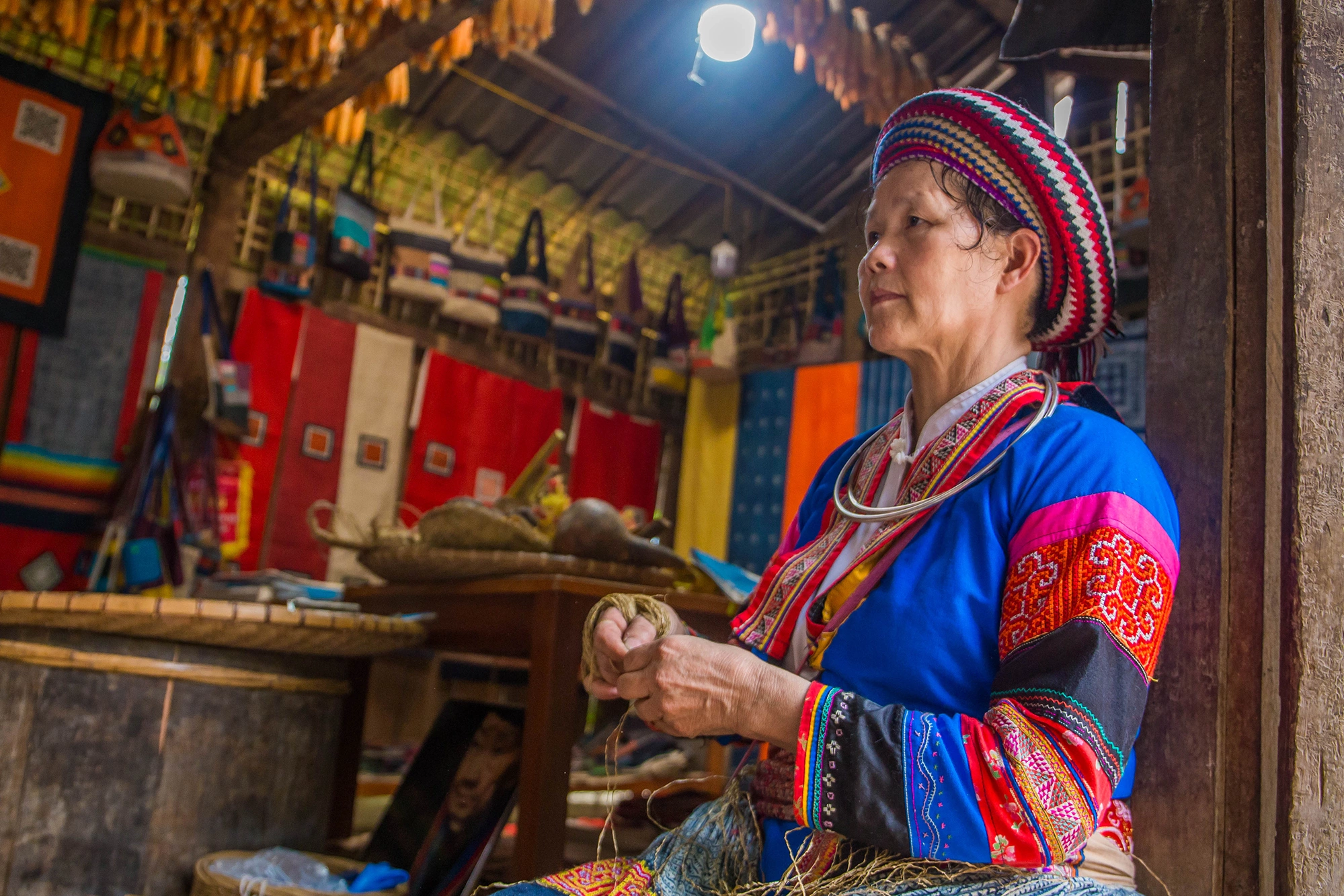
3. How Hmong Linen Is Made: Step-by-Step Weaving Process
The creation of Hmong linen begins with cultivating flax plants, which grow abundantly in the mountainous climate of Ha Giang. Farmers harvest mature plants after approximately three months, carefully selecting stems of optimal thickness. The timing of harvest significantly impacts fiber quality too early produces weak threads, while delayed harvests yield coarse, brittle fibers. After harvesting, stems undergo initial drying in filtered sunlight for several days before processing begins.
Once dried, workers separate fibers from the woody stem through a labor-intensive process requiring considerable skill. They first soak bundles in water to soften outer layers, then repeatedly beat them against flat stones to break down unwanted plant material. Women extract usable fibers by hand, meticulously pulling them away from the stem while maintaining length and strength. These raw fibers then undergo washing in ash-infused water to remove impurities and natural resins, followed by careful drying.
The transformation from fiber to thread involves spinning using traditional drop spindles or simple wooden spinning wheels. Artisans draw out and twist fibers with practiced movements, creating threads of consistent thickness. A skilled spinner produces enough thread for a single garment over approximately two weeks of daily work. This handspun thread then moves to natural dyeing processes or directly to looms where weavers create fabric through intricate patterns of interlacing warp and weft threads. The basic fabric requires further treatment with beeswax and stone polishing to achieve its characteristic sheen and softness.
3.1 Flax Cultivation and Fiber Preparation
Flax cultivation in Lung Tam follows ecological principles perfected over centuries of practice. Families typically maintain small plots dedicated to flax production, rotating locations to prevent soil depletion. The high-altitude environment with cool temperatures and moderate rainfall creates ideal growing conditions for developing strong, flexible fibers. No chemical fertilizers or pesticides enter the process, maintaining both environmental sustainability and fiber purity.
After harvesting, flax undergoes a critical process called retting the controlled decomposition of pectin that binds fibers to the woody stem. Traditional retting in Lung Tam occurs through morning dew exposure rather than water immersion, preserving fiber strength. This stage requires careful monitoring, as under-retted flax remains difficult to process while over-retted fibers weaken significantly. Experienced farmers judge completion by sight, smell, and touch, demonstrating knowledge transferred across generations.
The separation of fibers from stems involves specialized tools unique to Hmong culture. A wooden mallet called a “txhob” breaks the outer stem, while a “tshuaj” a flat paddle with teeth scrapes away unwanted plant material. Women then hand-comb the fibers using progressively finer tools, aligning individual strands for spinning. Throughout this preparation, workers grade fibers by quality, with the finest reserved for ceremonial garments and slightly coarser fibers directed toward everyday items. Nothing goes to waste even short fibers find purpose in household items or stuffing materials.
3.2 Dyeing, Embroidery, and Beeswax Techniques Explained
Natural dyeing practices in Lung Tam utilize indigenous plants, minerals, and insects to create a spectrum of colors with cultural significance. Indigo produces the characteristic blue prevalent in many Hmong textiles, derived from fermented leaves harvested locally. Yellow comes from turmeric or sophora flower, while red tones emerge from cinnabar, safflower, or cochineal insects. The cooperative maintains detailed records of dye recipes refined over generations, including mordant techniques using alum, ash, or iron to ensure colorfast results.
The application of beeswax represents one of the most distinctive elements of Hmong linen production. Artisans heat locally harvested beeswax to precise temperatures before applying it to finished fabric using bamboo tools. This process waterproofs the material while adding suppleness and a subtle sheen that increases with age and use. After waxing, women polish the fabric with smooth river stones, working systematically across the surface for hours until achieving the desired luster. This labor-intensive finishing process distinguishes Lung Tam linen from other textiles.
Embroidery transforms plain linen into culturally rich textiles telling complex visual stories. Traditional Hmong patterns include geometric motifs representing mountains, water, and celestial bodies alongside stylized animals and plants. The most skilled embroiderers create “story cloths” depicting historical events, myths, or ceremonies without written text. Modern pieces sometimes incorporate contemporary elements while maintaining traditional techniques. Hmong embroidery typically uses a couching technique where one thread holds another in place on the fabric surface, creating distinctive raised patterns that add both visual and tactile dimensions to finished pieces.
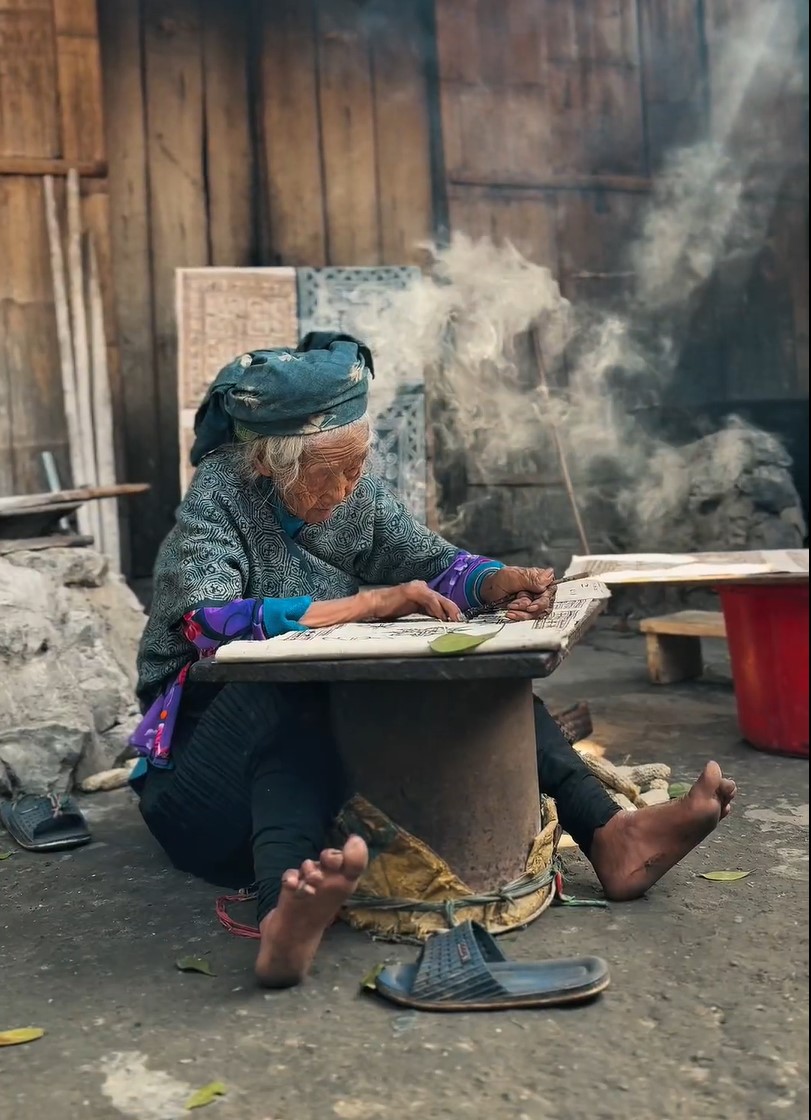
Then Pa Village Ha Giang the essential guide to this hidden h’Mong gem
4. Visiting Lung Tam: What to See, Do, and Buy
Visitors to Lung Tam can witness the complete linen production process through guided tours offered daily by cooperative members. The main production facility houses weaving looms, dyeing stations, and embroidery workspaces where artisans demonstrate each stage of creation. Tours typically last 60-90 minutes, with English, Vietnamese, and Hmong language options available. Photography is permitted throughout most areas, though visitors should request permission before taking close-up pictures of individual artisans. The cooperative maintains a relaxed, authentic atmosphere rather than staged demonstrations, allowing visitors to observe genuine production activities.
Beyond observation, the cooperative offers hands-on experiences for those wanting deeper engagement with Hmong culture. Half-day workshops teach basic weaving techniques, natural dyeing processes, or embroidery fundamentals under guidance from master artisans. More committed visitors can arrange multi-day immersive experiences including homestays with cooperative members’ families. These extended visits provide opportunities to participate in flax harvesting (seasonal), try traditional cooking, and join evening storytelling sessions. Advance booking for workshops is essential, particularly during peak tourism seasons between October and April.
The cooperative’s showroom displays an extensive range of handcrafted products available for purchase directly from producers. Traditional items include embroidered wall hangings, table linens, clothing, bags, and decorative household goods. Prices reflect fair compensation for labor-intensive handwork, with items ranging from $5 for small accessories to $200+ for intricate textiles requiring months of work. All purchases include documentation of authenticity and creator information. The cooperative accepts Vietnamese dong, major international currencies, and credit cards, with shipping services available for larger purchases. Visitors particularly value the opportunity to meet the specific artisans who created their purchases.
4.1 Responsible Tourism: How Your Visit Helps Preserve Hmong Heritage
Every visit to Lung Tam directly supports cultural preservation efforts through entrance fees and purchases. The cooperative allocates 15% of tourism revenue specifically to documentation projects, apprenticeship programs, and cultural education initiatives in local schools. These funds help record traditional techniques, songs, and stories associated with weaving practices that might otherwise disappear. Visitor contributions have enabled the creation of a small library containing bilingual resources about Hmong textile traditions accessible to both community members and researchers.
The cooperative implements sustainable tourism practices to minimize environmental impact while maximizing community benefits. They limit tour group sizes to preserve authentic workshop atmospheres and reduce disruption to production. Local families providing homestay accommodations receive training in balancing hospitality with cultural integrity, including fair pricing guidelines and waste reduction strategies. The cooperative encourages visitors to respect cultural sensitivities around photography, religious practices, and private ceremonies, providing clear guidelines upon arrival.
Tourism has created complementary economic opportunities beyond direct textile production. Local families now offer traditional meals, transportation services, and guided hiking tours to nearby villages. Young people find reasons to remain in the community rather than migrating to cities, preserving linguistic and cultural continuity. Most significantly, tourism has elevated the status of traditional women’s knowledge that was previously undervalued. As one elder artisan explained, “When people travel thousands of kilometers to learn what my grandmother taught me, I understand its true worth.” This recognition strengthens cultural pride while providing sustainable livelihoods.

Brocade Clothes in Ha Giang: 6 Ethnic Styles You Should Know
5. The Lung Tam Cooperative: Empowerment and Impact
The Lung Tam Linen Cooperative operates on a unique business model prioritizing both cultural preservation and women’s economic empowerment. Unlike conventional businesses, profits distribute through a tiered system where artisans receive compensation based on both production quantity and skill level. The cooperative maintains transparent financial management with members collectively determining resource allocation during monthly meetings. This democratic approach ensures the organization serves community needs rather than external interests. Administrative positions rotate among capable members, creating leadership opportunities while preventing power concentration.
Beyond income generation, the cooperative provides significant social support to its predominantly female membership. An internal education fund offers scholarships for members’ children, with special emphasis on girls’ access to higher education. The cooperative maintains childcare facilities enabling mothers to work while keeping young children nearby. Health initiatives include regular medical clinics, traditional healing workshops, and transportation assistance for members requiring hospital care in distant facilities. These support systems address practical barriers that previously limited women’s economic participation.
The cooperative’s impact extends well beyond economic metrics, creating profound social transformation within the community. Women who previously had little decision-making authority now manage substantial household income and participate actively in community governance. Domestic violence rates have declined significantly as women’s economic value gained recognition. Most remarkably, the cooperative has reversed outmigration patterns common in rural Vietnam young people increasingly choose to remain in Lung Tam, seeing viable futures combining traditional knowledge with sustainable development. The cooperative’s success demonstrates how cultural heritage can provide foundations for equitable community development.
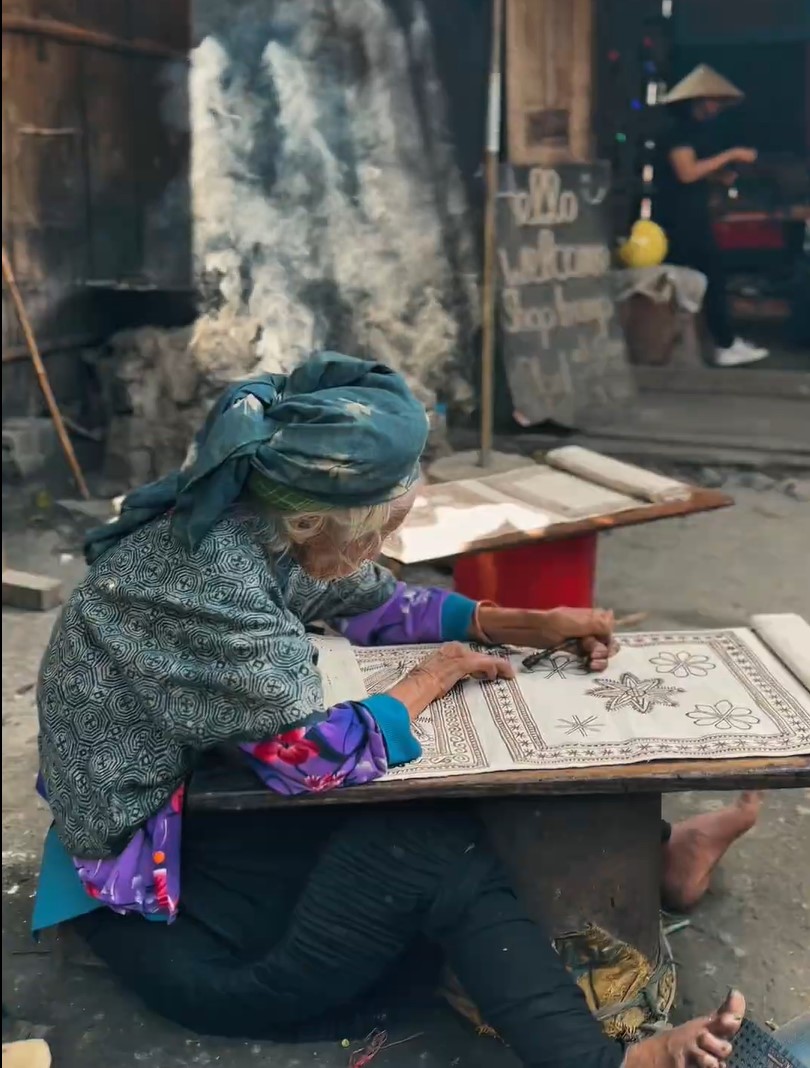
6. Lung Tam Linen Worldwide: From Ha Giang to Global Markets
From its humble beginnings focused on local markets, Lung Tam linen products now reach international audiences through carefully developed distribution channels. The cooperative maintains partnerships with fair-trade organizations in Europe, Japan, and North America, ensuring ethical marketing and appropriate cultural context for exported items. High-end boutiques in Hanoi, Ho Chi Minh City, and resort destinations like Hoi An showcase select pieces with detailed provenance information. Online sales through the cooperative’s website and partner platforms generate approximately 35% of annual revenue, connecting artisans directly with global customers.
Collaboration with contemporary designers has introduced Hmong textile traditions to new audiences while generating innovative applications for traditional techniques. Fashion designers incorporate authentic embroidery elements into modern clothing collections, while interior designers commission custom textiles for luxury hotels and residential projects. The cooperative maintains strict protocols for these collaborations, ensuring fair compensation and proper attribution for traditional knowledge. All collaborative products include educational components explaining cultural origins and production methods, preventing cultural appropriation while promoting appreciation.
International recognition has brought both opportunities and challenges to Lung Tam. Exhibition invitations from museums and cultural institutions provide platforms for sharing Hmong heritage with global audiences. UNESCO consideration for Intangible Cultural Heritage status would bring prestige and protection but also increased tourism pressure. The cooperative navigates these developments carefully, prioritizing sustainability over rapid growth. “Our success comes from maintaining our cultural integrity while adapting to changing markets,” explains cooperative leader Vang Thi Mai. “We measure growth not just in sales but in how many young people choose to learn our traditions and make them their own.”
6.1 How to Get to Lung Tam Village (Maps and Directions)
Reaching Lung Tam requires careful planning due to its remote location in Ha Giang’s mountainous terrain. Most visitors begin their journey in Ha Giang city, accessible via bus from Hanoi (approximately 6-7 hours). From Ha Giang city center, local buses serve Quan Ba district daily, departing from the main bus station every 2-3 hours between 6:00 AM and 2:00 PM. The bus journey takes approximately 2 hours along winding mountain roads with stunning scenery. Inform the driver you’re heading to Lung Tam village for drop-off at the nearest junction.
For more flexibility, many travelers hire motorbikes in Ha Giang city (around 150,000-200,000 VND daily) or arrange private car transport (approximately 600,000-800,000 VND each way). The route follows the famous Ha Giang Loop, crossing Quan Ba Heaven Gate before descending into the valley where Lung Tam is located. Road conditions vary seasonally, with best driving conditions from October through April during the dry season. During rainy months (May-September), certain sections may become slippery or experience minor landslides, requiring cautious driving.
The final approach to Lung Tam follows a small valley road branching from the main highway, marked by a simple wooden sign approximately 7km after passing through Quan Ba town. This final stretch extends about 3km on a narrow paved road that winds through terraced fields before reaching the village entrance. Limited mobile reception exists in the area, so downloading offline maps beforehand is advisable. The cooperative offers pickup services from the highway junction with advance notice, particularly helpful during inclement weather or for visitors traveling with luggage.
6.2 Travel FAQs for Lung Tam Visitors
A visit to the Lung Tam weaving village is a highlight of any Ha Giang Loop adventure. Phieu Travel specializes in crafting authentic tours that provide direct access to this incredible community. Our guides are here to ensure your visit is seamless, helping you navigate these frequently asked questions about your trip.
What is the best time to visit Lung Tam weaving village?
October through April provides ideal visiting conditions with dry weather and good road access. December through February offers crisp, clear days with stunning mountain views but cold temperatures, especially at night. The spring months (March-April) showcase blooming landscapes and increased weaving activity as artisans prepare products for summer markets. September brings the golden color of ripening rice terraces surrounding the village, creating magnificent photo opportunities.
Are there accommodation options in Lung Tam?
The village offers limited homestay accommodations with cooperative member families, providing authentic cultural experiences with basic comforts. These homestays include traditional meals and potential evening cultural activities. Advance booking is essential, particularly during peak tourism season. Alternatively, more developed accommodation options exist in Quan Ba town (7km away) or Yen Minh district (30km away), with guesthouses and small hotels available in various price ranges. The cooperative can arrange transportation between these locations and the village for day visits.
What should visitors bring when visiting Lung Tam?
Comfortable walking shoes are essential as the village spreads across uneven terrain. Cash in Vietnamese dong is necessary since ATM access is limited in the region. Modest clothing respecting local cultural sensitivities is appreciated, particularly when visiting homes or participating in cultural activities. A light jacket or sweater is recommended even in summer months, as mountain evenings cool quickly. Photography enthusiasts should bring spare batteries and memory cards, as charging opportunities may be limited in some areas of the village.
Can visitors purchase products directly from artisans?
Yes, direct purchases form an integral part of the Lung Tam experience. The cooperative maintains a central showroom displaying products from all members with consistent pricing and quality standards. Visitors seeking specific items can request introductions to particular artisans, though prices remain standardized to prevent competitive disruption within the community. The cooperative provides secure packaging for transport and can arrange international shipping for larger purchases through partnerships with logistics providers.
6.3 Buying Lung Tam Linen: Pricing, Products, and Export Details
Lung Tam’s product range spans traditional Hmong ceremonial textiles to contemporary adaptations designed for international markets. Basic items include table runners (300,000-600,000 VND), scarves (200,000-450,000 VND), and small decorative pieces (150,000-250,000 VND). Mid-range products feature embroidered wall hangings (600,000-2,000,000 VND), clothing items like jackets and vests (800,000-1,500,000 VND), and home accessories with traditional motifs. Investment-quality pieces include fully hand-embroidered story cloths (2,000,000-5,000,000+ VND), ceremonial garments, and commissioned custom works that may require several months to complete.
Pricing reflects the extraordinary labor investment each piece represents. A simple table runner requires approximately 15-20 hours of spinning, weaving, and finishing, while elaborate embroidered pieces may represent hundreds of hours of skilled handwork. The cooperative ensures artisans receive approximately 70% of the retail price, with remaining funds covering materials, facilities maintenance, and community development initiatives. Compared to machine-made imitations, authentic Lung Tam linen commands premium prices but offers exceptional durability, with properly maintained pieces lasting generations.
For international buyers, the cooperative provides comprehensive export services. All products include certification of authenticity with detailed information about materials, techniques, and artisan credentials. The cooperative handles export documentation, customs requirements, and shipping logistics through partnerships with established carriers. International orders can be placed through their website (www.lungtamlinen.vn) with secure payment options including credit cards and PayPal. Wholesale inquiries receive personalized attention from the cooperative’s export team, with minimum order requirements and lead times varying seasonally based on production capacity.
Lung Tam weaving village represents far more than a tourist destination it embodies the successful revitalization of indigenous knowledge through community-driven development. The cooperative has transformed traditional skills into sustainable livelihoods while maintaining cultural authenticity. Women who once struggled for economic recognition now lead a globally respected enterprise preserving Hmong heritage. Their achievement demonstrates how cultural preservation and economic development can work in harmony rather than opposition.
Visitors to Lung Tam witness the extraordinary journey of transformation from plant to thread to fabric to art all accomplished through human hands guided by ancient knowledge. Each textile carries within its fibers the stories, beliefs, and resilience of the Hmong people. The cooperative’s success offers valuable lessons about sustainable tourism, women’s empowerment, and the continued relevance of traditional knowledge in contemporary contexts. Through careful stewardship and innovation, the artisans of Lung Tam weaving village ensure their cultural heritage will continue inspiring future generations.
Read more:
- Ha Giang Jeep Tour by Phieu Travel: The Ultimate Adventure on the Ha Giang Loop (2025)
- 3 Days 2 Nights Ha Giang Loop tour package from Phieu Travel
- Cloud hunting in Ha Giang: 7 Breathtaking spots that will capture your heart
- Hoang Su Phi rice terraces ultimate travel guide 2025
- Explore Xa Phin Village Ha Giang Tea Culture and Local Life
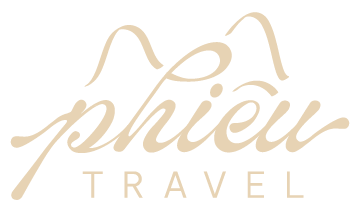
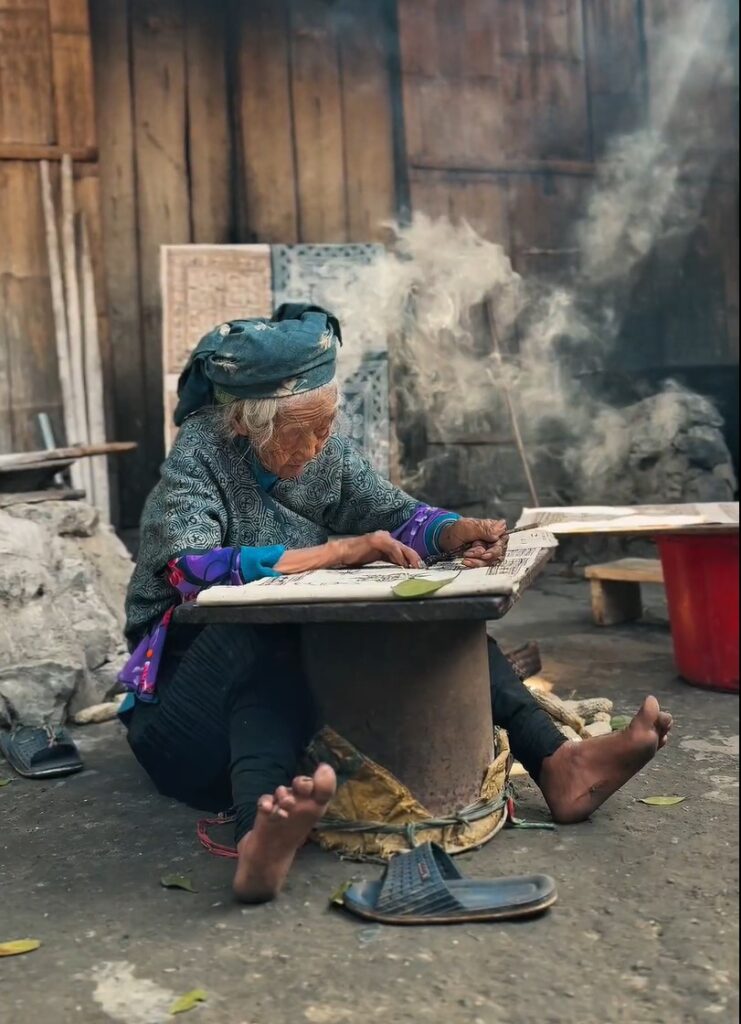
You Might Also Like
Ha Giang Weather in September: Complete Guide for Travelers
Exploring the magnificent Ha Giang Loop in September offers travelers a perfect balance of favorable[...]
Quan Ba Twin Mountains: Ha Giang’s Iconic Fairy Hills and Complete Travel Guide
The mystical Quan Ba Twin Mountains rise from the emerald valleys of Ha Giang like[...]
Vuong family mansion: the architectural marvel and cultural legacy of Ha Giang
Deep in Vietnam’s northern highlands, where mist-shrouded mountains meet terraced rice fields, stands a testament[...]
Ha Giang Loop Safety Tips: How to Ride Securely in Vietnam’s Northern Mountains
The Ha Giang Loop, with its winding mountain roads and breathtaking landscapes, offers one of[...]
The Ultimate Guide to the M-Shaped Curve on Ha Giang Loop
Vietnam’s remote northern province of Ha Giang hides a natural wonder that has captivated adventurous[...]
Most Beautiful Places to Visit in Vietnam: Essential Destinations and Insider Tips
Vietnam captivates travelers with its stunning landscapes, rich cultural heritage, and warm hospitality. From mist-shrouded[...]
Beyond the Beaten Path: Discovering Ha Giang Province in Northeast Vietnam
Ha Giang Province in Northeast Vietnam stands as one of the country’s last frontiers for[...]
Rainy season in Ha Giang: what to expect, when to go, and travel tips
Vietnam’s northern frontier reveals a different face during the rainy season, transforming Ha Giang’s limestone[...]